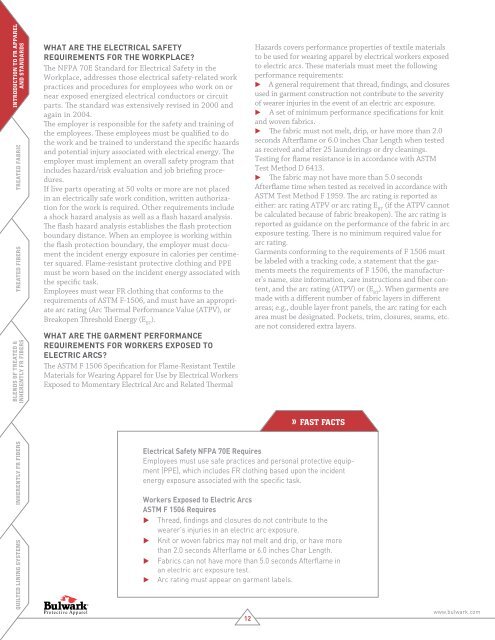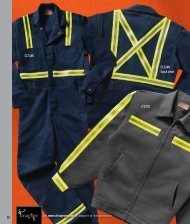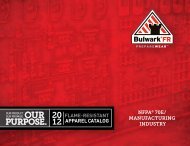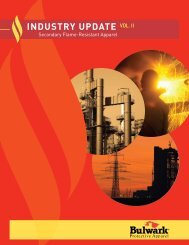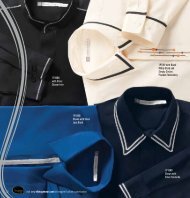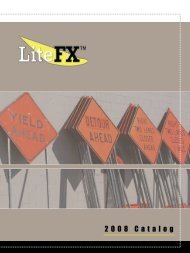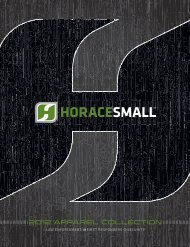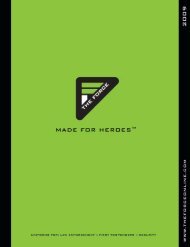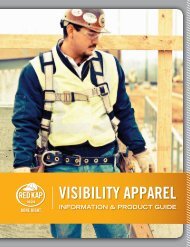VOL. 10 - Red Kap Work Clothes, Uniforms, & Coveralls
VOL. 10 - Red Kap Work Clothes, Uniforms, & Coveralls
VOL. 10 - Red Kap Work Clothes, Uniforms, & Coveralls
Create successful ePaper yourself
Turn your PDF publications into a flip-book with our unique Google optimized e-Paper software.
introduction to fr apparel<br />
and standards<br />
treated fibers treated fabric<br />
BLENDS OF TREATED &<br />
INHERENTLY FR FIBERS<br />
What are the electrical safety<br />
requirements for the workplace?<br />
The NFPA 70E Standard for Electrical Safety in the<br />
<strong>Work</strong>place, addresses those electrical safety-related work<br />
practices and procedures for employees who work on or<br />
near exposed energized electrical conductors or circuit<br />
parts. The standard was extensively revised in 2000 and<br />
again in 2004.<br />
The employer is responsible for the safety and training of<br />
the employees. These employees must be qualified to do<br />
the work and be trained to understand the specific hazards<br />
and potential injury associated with electrical energy. The<br />
employer must implement an overall safety program that<br />
includes hazard/risk evaluation and job briefing procedures.<br />
If live parts operating at 50 volts or more are not placed<br />
in an electrically safe work condition, written authorization<br />
for the work is required. Other requirements include<br />
a shock hazard analysis as well as a flash hazard analysis.<br />
The flash hazard analysis establishes the flash protection<br />
boundary distance. When an employee is working within<br />
the flash protection boundary, the employer must document<br />
the incident energy exposure in calories per centimeter<br />
squared. Flame-resistant protective clothing and PPE<br />
must be worn based on the incident energy associated with<br />
the specific task.<br />
Employees must wear FR clothing that conforms to the<br />
requirements of ASTM F-1506, and must have an appropriate<br />
arc rating (Arc Thermal Performance Value (ATPV), or<br />
Breakopen Threshold Energy (E BT<br />
).<br />
What are the garment performance<br />
requirements for workers exposed to<br />
electric arcs?<br />
The ASTM F 1506 Specification for Flame-Resistant Textile<br />
Materials for Wearing Apparel for Use by Electrical <strong>Work</strong>ers<br />
Exposed to Momentary Electrical Arc and Related Thermal<br />
Hazards covers performance properties of textile materials<br />
to be used for wearing apparel by electrical workers exposed<br />
to electric arcs. These materials must meet the following<br />
performance requirements:<br />
u A general requirement that thread, findings, and closures<br />
used in garment construction not contribute to the severity<br />
of wearer injuries in the event of an electric arc exposure.<br />
u A set of minimum performance specifications for knit<br />
and woven fabrics.<br />
u The fabric must not melt, drip, or have more than 2.0<br />
seconds Afterflame or 6.0 inches Char Length when tested<br />
as received and after 25 launderings or dry cleanings.<br />
Testing for flame resistance is in accordance with ASTM<br />
Test Method D 6413.<br />
u The fabric may not have more than 5.0 seconds<br />
Afterflame time when tested as received in accordance with<br />
ASTM Test Method F 1959. The arc rating is reported as<br />
either: arc rating ATPV or arc rating E BT<br />
(if the ATPV cannot<br />
be calculated because of fabric breakopen). The arc rating is<br />
reported as guidance on the performance of the fabric in arc<br />
exposure testing. There is no minimum required value for<br />
arc rating.<br />
Garments conforming to the requirements of F 1506 must<br />
be labeled with a tracking code, a statement that the garments<br />
meets the requirements of F 1506, the manufacturer’s<br />
name, size information, care instructions and fiber content,<br />
and the arc rating (ATPV) or (E BT<br />
). When garments are<br />
made with a different number of fabric layers in different<br />
areas; e.g., double layer front panels, the arc rating for each<br />
area must be designated. Pockets, trim, closures, seams, etc.<br />
are not considered extra layers.<br />
» FAST FACTS<br />
quilted lining systems INHERENTLY FR FIBERS<br />
Electrical Safety NFPA 70E Requires<br />
Employees must use safe practices and personal protective equipment<br />
(PPE), which includes FR clothing based upon the incident<br />
energy exposure associated with the specific task.<br />
<strong>Work</strong>ers Exposed to Electric Arcs<br />
ASTM F 1506 Requires<br />
u Thread, findings and closures do not contribute to the<br />
wearer’s injuries in an electric arc exposure.<br />
u Knit or woven fabrics may not melt and drip, or have more<br />
than 2.0 seconds Afterflame or 6.0 inches Char Length.<br />
u Fabrics can not have more than 5.0 seconds Afterflame in<br />
an electric arc exposure test.<br />
u Arc rating must appear on garment labels.<br />
12<br />
www.bulwark.com


